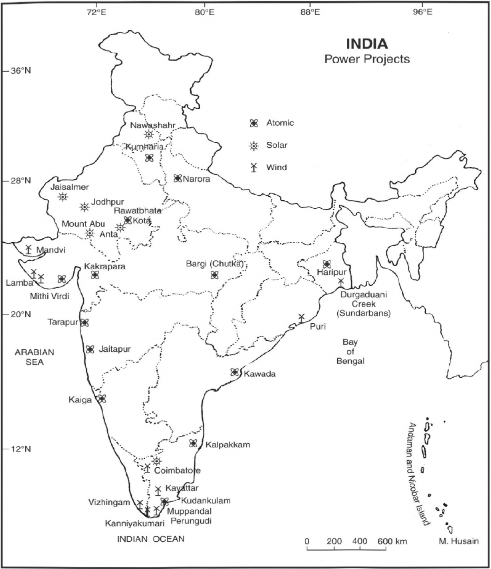Wind Energy
Wind is an important source of non-conventional energy. It is cheap, pollution free, eco-friendly and can be developed away from the sources of fossil fuels (conventional sources of energy). Since ancient times wind energy was utilised in sailing ships and wind mills. India ranks 5th in the world after U.S.A., Spain, Germany and China.
For the generation of wind energy, a wind speed of more than five km per hour is considered to be suitable. Wind speeds above 10 km per hour are prevalent over parts of the coastal regions of Gujarat, Andhra Pradesh, Karnataka, Madhya Pradesh, Rajasthan, Tamil Nadu, Maharashtra, Kerala, Odisha, West Bengal,
Uttarakhand, Jammu & Kashmir, and Andaman and Nicobar Islands
(Fig. 8.8). The state of Rajasthan and Ladakh also record suitable consistency of wind speed. Wind mills can be operated there to harness wind energy.

Fig. 8.8 Power Projects
Table 8.13 India—Wind Power Potential
State | Total Potential (MW) | Technical Potential (MW) |
1. Gujarat | 9675 | 1750 |
2. Andhra Pradesh | 8275 | 1550 |
3. Karnataka | 6620 | 1025 |
4. Madhya Pradesh | 5500 | 1200 |
5. Rajasthan | 5400 | 0885 |
6. Tamil Nadu | 3050 | 1700 |
7. Others | 6675 | 4725 |
Total | 45,195 | 12,835 |
Source: Ministry of Non-Conventional Sources of Energy.
In India, the total potential of wind energy is estimated to be more than 20,000 MW. Wind energy projects have been implemented in 22 states of the country. The maximum potential of wind energy lies in the states of Gujarat and Tamil Nadu. Asia’s largest wind farm of 28 MW capacity is located at Lamba in Gujarat. Commercial projects of 1200 MW capacity have been set up in Tamil Nadu, Gujarat, and Andhra Pradesh.
Tamil Nadu has the largest installation of wind turbines in the country in the Muppandal Perungudi area near Kanniyakumari. This is one of the largest concentrations of wind farm capacity at a single location anywhere in the world. A Centre of Wind Energy Technology has been set up in Chennai. The Wind Energy Estates are being set up in the joint sector or in private sector.
